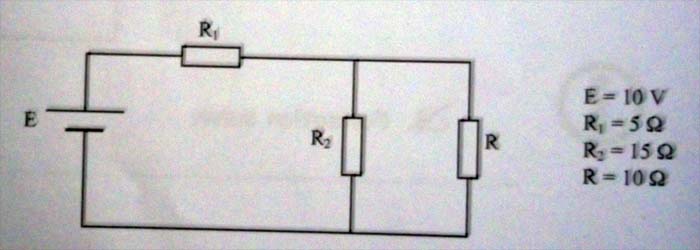I’M wondering if my calculs are true.
July 28th, 2013
Here i wanna know the power dissipation in the resistor R

R2=15 ohms / R= 10 ohms = 5.999999999999999 ohms
R1= 5 ohms + R= 10 ohms= 6000000000000009 ohms
R= 6000000000000009
the couran I=U/R, U=10V / R=6000000000000009 = 1,6666666666666641666666666666704e-15 A or 1,66 Ampères
the power P=UxI, U=10V x 1,66 A= 16,6 Watts
can do the power dissipation in R = 16,6 watts
Is that correct ?
E=Rtotal*I
Rtotal= R1+ (1/R2)+(1/R)
Rtotal=5+(1/15)+(1/10)
Rtotal=31/6
Rtotal=5,16667 ohms
E=Rtotal*I
10=5,16667*I
I=1,93548 ampers
current at R is;
I=(1,93548/25)*15
I=1,16129 ampers
voltage at R is;
E=R*I
E=10*1,16129
E=11,6129 volts
power at R is;
P=E*I
P=11,6129*1,16129
P=13,4859 W
thanks but one friend friend tell me thats false, look :
Myself in your place I would use the formula:
Rt = 1 / (1/R1 +1 / R2 + ...) directly to you as its response Ohm
what gives you:
Rtotal: R1 + (= 1 / (1 / R +1 / R2)
So 5 + (1/10 +1 / 15) = 11 Ohm
A faith that you Total resistance of the circuit and the voltage you have to find the total current of the circuit
I = E / I = Rtotal 10V/11ohm = 0.9 amps
Then you must find the voltage drops of resistors:
For R1: R1 = U * I = 5 Total = 4.5 * 0.9 Volt
For R1 and Réquivalent A: U = (1/10 +1 / 15) * 0.9 = 5.4 Volt
And as you know that the voltage drops in / / are the same Ur = Ur2
So the current through your resistor is I = V / RI = 5.4 / 10 = 0.54 amps
Then you use for power P = I2 R * Heat dissipation is therefore 10 * 0.542
What makes you 2.92 Watt
i need help again
Because R2 and R are in parallel with each other you take the reciprocal of each then add those values together. Next you take the reciprocal of that value in order to get back to an R value. The result is a resistance that can simply be added to that of R1 because R1 is in series with those other two. The result is the total resistance of your circuit (ignoring the internal resistance of the battery). Tell me what total R you come up with.
urkatat replied:
Rtotal= R1+ (1/R2)+(1/R)
This is where you made a mistake. It should read;
Rtotal= R1+1/[(1/R2)+(1/R)]
sorry for posting in series…don’t know how to delete.
Rtotal: R1+(=1/(1/R+1/R2)
so 5+(1/10+1/15) = 11 Ohm
R1 : U = R1*I total = 5*0,9 = 4,5 Volts
équivalent resistance of R1 et R : U = (1/10+1/15)*0,9 = 5,4 Volts
the current in the resistance is I=U/R I=5,4/10= 0,54A
P=R*I2 the dissipated power is 10*0,542
that is 2,92 Watts
Thats true or false ?
It’s correct, here’s a readable step by step calculation:

http://paste bin.com/PqfNFBJA
thanks a lot .GhostShot.
You’re welcome.
To be honest, I didn’t look at your original proposal. Do you understand what you did wrong?
Basically, voltage decreases after each “element” in series. (Seen in: U = U_R1 + U_R2R) When you have parallel elements, voltage is the same on both lanes until they join again. (Seen in: U_R2 = U_R2R when calculatiung I_R at the very end)
The electric current has the exact opposite behavior: It splits up in parallel circuits and is constant in series. Ampères tell you, how much charge passes through a point during a second. If you think of charge being made up of individual electrons, it’s very easy to picture how this works: If you have elements in series, the electrons will pass through each and every one of them. If you have elements in parallel, however, the electrons can’t travel through both ways, correct? That’s why a part will go one way, and another part a different way.
Yes i do understand, i’m just new in this catégorie that’s why
The Leecher replied:
urkatat replied:
Rtotal= R1+ (1/R2)+(1/R)
This is where you made a mistake. It should read;
Rtotal= R1+1/[(1/R2)+(1/R)]
yea, i see it now, i am sorry for the mistake.
no problem